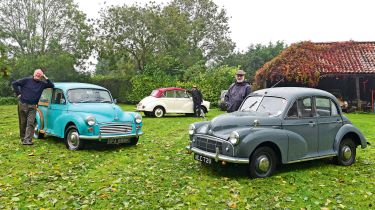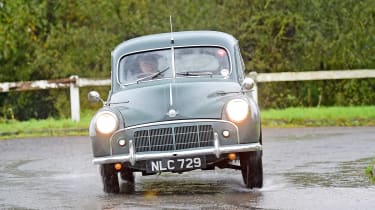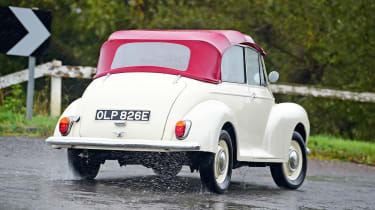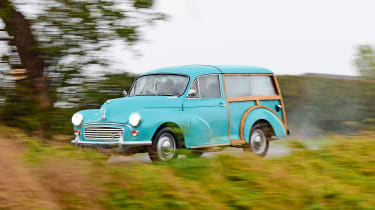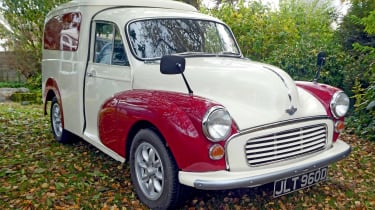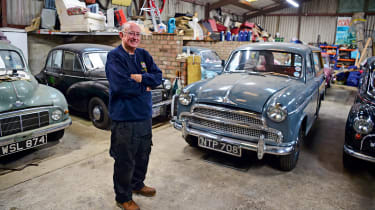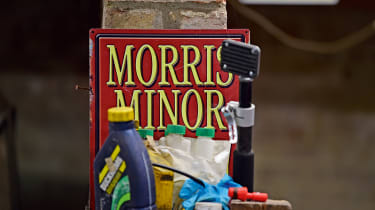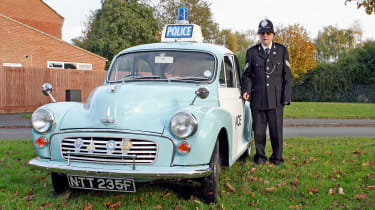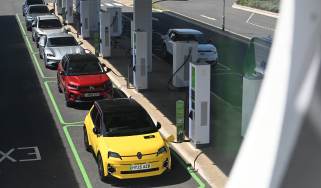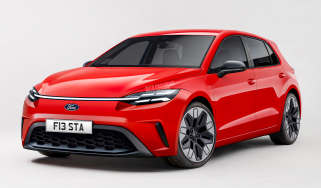Morris Minor: owners pay tribute to British motoring icon
To mark the Morris Minor’s 75th anniversary, we got together with some Moggy fans and their cherished cars
The British motor industry had a huge year in 1948. It was 75 years ago that Land Rover was born, Jaguar launched its XK120, Colin Chapman (of Lotus fame) built his first car, and Morris introduced the Minor. Across the Channel, Citroen pulled the wraps off the 2CV, while Porsche launched its first model, the 356.
All of those cars have endured, but for a certain band of enthusiasts it’s the Minor that’s king. The first British car to sell more than a million, the Minor is a classic, thanks largely to a thriving owners’ club and specialists, who can provide pretty much anything to keep a Moggy ticking over.
In 1943 Alec Issigonis started producing drawings for an innovative post-war family car, but he didn’t get the brief to design a compact four-seater codenamed Mosquito until hostilities were over. Given a free hand by Morris to create something cutting-edge, Issigonis envisaged an affordable saloon with unitary construction and a flat-four engine driving the front wheels. Coil spring and wishbone suspension would feature at the front, along with rack-and-pinion steering. Then reality hit and everything was downgraded; cue a 918cc side-valve engine carried over from the pre-war Morris Eight, driving the rear wheels.
The first prototype retained the Eight’s dimensions, so there was hardly any interior space, which is why the bodyshell was widened by four inches after the initial prototype had been built. With this job done, the Minor was born – or the poached egg, as Morris boss Lord Nuffield disparagingly called it when he first saw it.
Saloon
(Built 1948-1971)
When the Minor was unveiled in October 1948, it was in saloon and convertible forms, in both cases with two doors only. As soon as the car was unveiled, the press and public went wild, all madly enthusiastic about this new wonder machine that made its competitors look dated. The adoption of independent front suspension produced a car that was comfortable yet handled well, helped by the use of 14-inch wheels when 17-inch rims were the norm.
Despite so many key cars being unveiled alongside it, the Minor was the star of the 1948 Earls Court Motor Show. Priced at £358, the Morris was £32 more expensive than the Ford Anglia with its pre-war styling, but a lot cheaper than anything Austin or the Rootes Group had to offer. The motoring press adored the Minor, but Brits couldn’t get their hands on one, because until 1952 the Minor was generally available for export only. When Morris could finally sell freely in its home market, the orders flooded in, and by 1961 the Moggy had become the first British car to sell a million. Morris marked this with 350 copies of the Minor Million, each with lilac paint and white interior trim, all two-door saloons with the 948cc engine.
The saloon pictured is by far the oldest Minor here, and it’s the only one with the side-valve engine fitted to the earliest cars. Simon Ekins bought it earlier this year, but he’s no newcomer to Minor ownership. He says: “I remember driving my dad’s 1931 Morris Cowley up and down the drive when I was 14; we repainted it together on one occasion, using Valspar applied with a brush. When I passed my test, I bought a 1936 Morris Eight for £10, then in the early nineties I sold my modern Fiat to buy a 1967 Minor Traveller as my everyday transport. I loved it; there’s just something about the shape and all that wood down the sides.
“Over the years I’ve owned a few Minors, but this one came up in April and I just had to have it, as I had always wanted a split-screen edition. A 1952 car that’s won lots of concours prizes, it’s largely original, which means the 918cc engine has just 27.5bhp, so the acceleration is leisurely. But once it gets going, it cruises nicely at 40-45mph.”
Open season
(Built 1948 -1969)
We’re not sure that a car has ever been built which is more charming or quintessentially British than a Minor convertible, which Morris marketed as the Tourer. This example is owned by Will and Caroline Dickson.
Will notes: “When I was 12, my dad had a Minor with a ropey engine. One day he announced that we were going to swap its 948cc engine for a better one out of a smashed-up Austin A35. What he really meant was that I was going to change the engine; he’d give me instructions at each stage, but most of the time he’d be inside watching the telly while I toiled away outside. Looking back it seems mad now, but it set me up for a lifetime of fixing cars, and I went on to set up a village garage and then a classic-car restoration workshop.”
Back in the late eighties, one of Will’s customers came into the garage with a request: he wanted a basic car, so a Minor saloon that needed some fettling was tracked down, and this was returned to the road. The car was then handed over, only for the customer to announce that he had something in his garage that he needed to sell: a two-door Minor saloon! Will and Caroline decided to buy it and use it as their family transport, and since then they’ve run a string of Minors of every type, including a van and a pick-up.
Will adds: “A few years ago our daughter got married and wanted a Minor Tourer for her wedding car, so we bought the one in the pictures. Our other daughter then got hitched and asked for another Tourer to go with our first one, because she had more bridesmaids. We’ve ended up with a matching pair, but the later car has had a few tweaks for regular use.
“The Minor is a brilliant car, but for us a key attraction is the social scene and the club. A few years ago we were touring the west coast of Scotland in our Minor, when the starter motor packed up. We rang the club, who gave us the details of a member who could help. He had a spare starter motor in his shed so we drove over there, bought the part and fitted it the next morning. Many of the parts fitted from very early in production will fit the last examples made.
“They’re also very easy to work on. Caroline ground to a halt in the local square on market day. She jumped out, took off her shoe and used it to give the fuel pump a good whack. The car sprang back into life and she drove off, having received a round of applause from the local traders.”
Travelling man
(Built 1953-1971)
The Minor Traveller was a natural fit in the Minor range; the van version had already been launched, and Morris already offered the bigger Oxford MO in load-lugging form. Inspired by the woodies that were so popular in the US at the time, the Traveller was the same as the saloon ahead of the B-pillar, but behind the doors was all-new bodywork, including an ash frame that gave the car its strength. Priced at £442 when it was introduced in autumn 1953, the Traveller proved to be another hit for Morris, which would offer the same car for the next 18 years, with relatively few changes.
Terry Johnson’s Minor Traveller is one of the last made, and while it’s not completely standard, that eye-popping blue paint is the original hue (officially labelled Aqua, since you ask). As with everyone here, Terry is a serial Minor owner, having owned a string of them since he bought his first in 1964. The Traveller arrived five years after the Minor saloon was unveiled; back then few car makers offered estate cars, with some rivals relying on independent companies to convert their saloons into load carriers.
Says Terry: “The Minor was always considered to be a good workhorse, which is why I bought that first one in the sixties. I took it all over the place and it never gave me any trouble, so when I retired in 2000 I knew exactly which classic car I was going to buy as a project to restore: a Minor Traveller.
“Club member Sandy Hamilton had just the vehicle, so I did it up with his help, learning lots from him along the way. That’s why membership of the owners’ club is so important; Sandy had the knowledge, the tools and the parts, which enabled me to return the Traveller to the road.
“Six years ago I sold that Traveller and replaced it with the one you see here, bought for just £500. It was in much better condition than I expected, so it was an easy restoration,” Terry explains “At the end of Minor production, Morris received a bulk order from a company, for 60 Travellers with a 1,275cc engine. This engine was never officially offered in the Minor, although many have since been fitted to pep things up a bit. The V5 claimed this was a Minor 1300, but the 1,275cc engine had been swapped for a 1,098cc unit; I reversed the change and the car now has plenty of go to keep up with modern traffic, while the fitment of disc front brakes and LED headlight bulbs makes it that bit more usable.”
Minor commercials
(Built 1953-1971)
Light Commercial Vehicles (or LCVs) accounted for about 326,000 of the Minors built, but hard lives, and a lack of interest in them until it was too late, mean there aren’t many left. Five years after the Minor saloon appeared, the 1/4-Ton Van arrived, along with a pick-up version. Based on the Series II Minor, these first commercials featured a split windscreen and an 803cc overhead-valve engine with the bodyshell sitting on a separate chassis.
In October 1956 the Series III appeared with a 948cc A-series engine and a one-piece windscreen, but the most usable Minor LCV of all arrived in September 1962: the Series V (there was no Series IV), with a 48bhp 1,098cc A-series engine. In 1968 an Austin-badged Minor LCV entered showrooms to take over from the A35 van; the final Minor LCV was built in December 1971.
Garry and Cheryl Steele own the Minor van. Garry says: “One of my first memories is from the late fifties, when I was a small boy and the local butcher made weekly deliveries to our house out of the rear of his Minor van, and I can still remember that distinctive exhaust sound.
Cheryl and I got married in 1978 and I passed my test only just before, so money was tight. I was offered a 1965 Minor saloon for £60, so I snapped it up and we used it as our everyday transport. The webbing had gone on the driver’s seat, and with Cheryl being quite small she’d sit with the seat resting on top of a thick length of wood so that she could see over the dashboard. We didn’t worry so much about health and safety in those days!
“Once I’d bought the Minor, what became immediately apparent was how everyone I knew could relate to it; they’d owned one, learned to drive in one or had a family member who owned one. That original saloon was replaced by another, then in 1983 I spent the greater part of our meagre savings on a 1956 Tourer which we still own, and even though it has just a 948cc engine in place of the original 803cc unit, it has taken us on many adventures in mainland Europe over the years.
“The plan is to do the same with the van, which we bought seven years ago. Cheryl uses a mobility scooter and we needed a Minor that could carry it, so that we could continue to enjoy touring and taking part in club events. We use a couple of ramps and the scooter goes easily in the back of the van.”
Meanwhile, the pick-up pictured above left is owned by Brian Liggins, who acquired the commercial Moggy a decade ago. He says: “It had been laid up for 23 years and needed a lot of restoration, but I bought it and returned it to the road. I never went looking for a classic car and never thought I would ever own one. While it wasn’t built with comfort in mind, because it’s drafty, noisy and the suspension is basic, it still has the ability to put a smile on people’s faces wherever she goes, which is very satisfying.
“The Minor has taken me to Holland, France, Belgium, the Isle of Man and Scotland. On one trip to Germany she blew the head gasket and suffered valve damage, but a member of the German Morris Minor club came to the rescue, offering us a rebuilt engine that he had ready to go. We fitted it and continued our trip; that’s the power of the Minor community.”
Hooked on Minors
Sandy Hamilton has a clowder of 15 Moggies in his garage, but they’re not the only Minors he’s owned
The word ‘stalwart’ was made for Sandy Hamilton, who has a 15-strong addiction to Morris Minors. That’s not how many he has owned by the way – it’s how many he currently has, including many early examples. He’s a leading light of the Morris Minor Owners’ Club (mmoc.org.uk), and it all started in 1953 when Sandy’s father bought a new Minor saloon, which was kept until 1969. By then Sandy and his wife Rosie had bought their first Minor, but it was only in 1989 that they joined the MMOC, which had burst onto the scene 11 years earlier.
Sandy comments: “In 1989 I had a stressful job and wanted something that offered me some escape. I found a 1953 Minor saloon, built just two days after my dad’s 1953 example. Then I fancied
a side-valve car, so I tracked one down and within a month I’d bought another saloon and added that to the collection. Things just multiplied after that; I was up to 20 Minors at one point. When Rosie and I went on holiday to Canada in 1996 we ended up bringing back a 1950 example, which is the oldest-known four-door saloon in the UK.
“Minor ownership brings enthusiasts together from all walks of life; you get to meet all sorts of people who you wouldn’t otherwise meet. We’ve also had a lot of experiences that we wouldn’t have had, including many European trips through the MMOC’s annual Minors on Tour, which goes to different places. For us, the Minor is the perfect classic car and the MMOC is the perfect club.”
Minor evolution
The Minor made its debut in October 1948 as the series MM, otherwise known as the low-light, because its headlamps were mounted low down in the grille. At first it was available only as a two-door saloon or a convertible named the Tourer, but following UK introduction of the Series II in February 1953, the Traveller joined the range that autumn.
The headlamps had been relocated to the top of the front wings in 1949, and the four-door saloon arrived a year later, so the main change for the Series II was the adoption of the 30bhp A-series 803cc overhead-valve engine in place of the 27.5bhp Morris Eight Series E-derived 918cc side-valve unit that had previously been fitted.
In 1956 there were major changes, with the launch of the Minor 1000. Not only was a 948cc version of the A-series engine introduced, but the split windscreen became a single-piece unit and a larger rear window was fitted. The final variation on the theme was the (unofficially titled) Minor 1100, which despite having a 1,098cc engine was still sold as the Morris 1000; it reached showrooms in September 1962. The Minor 1100 used a 48bhp version of the 1,098cc A-series powerplant and the front drum brakes were enlarged.
By the time UK production of the model ceased in December 1971 (New Zealand production continued until 1974), 1,293,331 Minors had been made, plus 326,626 commercial editions; the latter figure includes three years’ worth of Austin-badged vans.
| Model | Series MM | Series II | Series III | Series V |
| Built | 1948-1953 | 1953-1956 | 1956-1962 | 1962-1971 |
| Engine | 918cc, 27.5bhp | 803cc, 30bhp | 948cc, 37bhp | 1,098cc, 48bhp |
| Top speed | 60mph | 62mph | 72mph | 73mph |
| Number made | 176,002 | 269,838 | 544,048 | 303,443 |
Fair cop
Across the UK in the sixties, towns and villages were teeming with panda cars such as Mike Sharp’s, which was first registered to Devon & Cornwall Police in June 1968. He and his daughter Lynda bought the car 20 years ago, thinking that it just needed a bit of light work. But it had been badly bodged and needed a complete restoration; now the car is in better shape than when it rolled out of Morris’s Cowley factory.
Mike says: “When we bought our Minor it wasn’t presented as a police car, but we knew that it started out as one, so we tracked down the uniforms, a two-way radio and the roof-mounted light box.
“We also had it restored as a panda car and now it gets lots of attention wherever we take it, which is mainly to classic-car shows. Last year it was one of 19 Minors that took part in the Queen’s Jubilee Pageant, which was a fabulous experience; look at the footage online and you can see Lynda and me in our uniforms, as our Minor drives past the crowds.”
Minor purchase
Handy tips if you’re buying a Moggy
Fancy your own Minor? Start by joining the Morris Minor Owners’ Club and buy one from a fellow club member. Prices begin at £3,000 for a usable saloon, while reasonable Travellers and Tourers are £5,000-plus. The best Minors fetch between £15,000 and £18,000, but vans and pick-ups can command up to £22,000 when they come onto the market, which isn’t often.
Really ropey cars can look fundamentally good, so an expert inspection is recommended before making a purchase. Underside rot is common and the Traveller’s wood is structural, so it really needs to be in tip-top condition – but often isn’t. Some saloons are converted (often very poorly) to Tourers and passed off as the real thing. The chassis plate is on the driver’s side bulkhead; the second letter of a 1952-1958 Tourer’s chassis number will be C, while later cars used a MAT prefix. Any car built after June 1969 will be a conversion.
Examples with the later A-series engines (948cc or 1,098cc) are a good bet in terms of usability and parts availability. Engine oil leaks are normal, as is a bit of smoke on start-up. But if there’s clouds of it, and if there’s any hint of knocking, an engine rebuild is due.
Gearboxes are Morris Minor weak points and parts are hard to find, except for 1,098cc editions. Leaking shock absorbers aren’t unusual with Moggies, either, but everything can be sourced cheaply to put things right, and upgrades are readily available.
Have you owned a Morris Minor? Tell us about your memories in the comments section below...
Find a car with the experts

